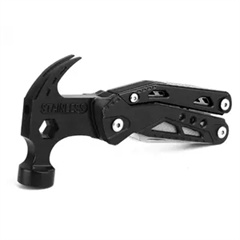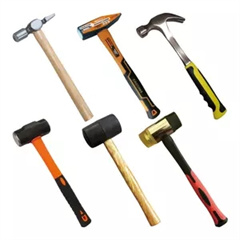The art of making hammers, also known as blacksmithing or metalworking, involves crafting these essential tools from raw materials like steel. Historically, blacksmiths were skilled craftsmen who created a variety of metal objects, including hammers. While modern manufacturing has largely automated this process, traditional hammer-making techniques are still appreciated by artisans and enthusiasts. Here’s an overview of the art of making hammers:
- Material Selection: The first step in making a hammer is choosing the right type of steel. The steel should have the appropriate hardness and durability for the intended use of the hammer.
- Forging: Forging is the heart of blacksmithing. The selected steel is heated in a forge until it reaches a malleable state. The blacksmith then uses various tools, like hammers and anvils, to shape the steel into the desired form. For hammer-making, this includes creating the hammerhead, the striking face, and the peen (the end opposite the striking face).
- Heat Treatment: Once the hammerhead is shaped, it’s important to heat treat it to enhance its hardness and toughness. This involves heating the steel to a specific temperature and then rapidly cooling it, usually in oil or water. This process, known as quenching, strengthens the steel.
- Tempering: After quenching, the hammerhead may be too hard and brittle. To achieve the right balance of hardness and toughness, the blacksmith will temper the hammerhead by reheating it to a lower temperature and then allowing it to cool slowly. This reduces the hardness while maintaining strength.
- Handle Preparation: The handle of a hammer is traditionally made from wood, such as hickory, which is known for its strength and shock-absorbing qualities. The blacksmith will shape the handle to fit the hammerhead’s eye (the hole where the handle is inserted).
- Assembly: The handle is inserted into the hammerhead’s eye. Traditionally, the handle is secured using a wooden wedge driven into a slot cut into the end of the handle. This expands the wood, securing it tightly within the eye of the hammerhead.
- Finishing: After assembly, the hammer is often sanded or polished to smooth out any rough edges. Some blacksmiths add decorative touches or engravings to personalize the hammer.
- Quality Control: The finished hammer undergoes quality checks to ensure its balance, weight, and structural integrity are appropriate for its intended use.
- Variations: Different types of hammers are designed for specific tasks, such as claw hammers for general construction, ball peen hammers for metalworking, and cross peen hammers for shaping metal.
Creating hammers through traditional blacksmithing techniques requires a deep understanding of materials, heat treatment, and metalworking skills. While modern manufacturing has made hammers more widely accessible, handcrafted hammers made by skilled artisans are still highly valued for their craftsmanship, durability, and unique character.



































